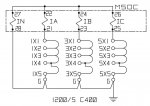The image below depicts the factory wiring for 1200:5 MR CTs connected to an overcurrent relay. If instead you wanted to connect the relay to taps X2-X4 (to obtain a 600:5 ratio), what would be the correct way to do it?
Would you still leave X5 as the grounded tap? Or would you move your grounding to the new center point (X4)?
Would you still leave X5 as the grounded tap? Or would you move your grounding to the new center point (X4)?


